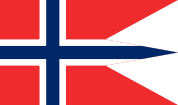Norwegian Army
| Norwegian Army | |
|---|---|
 Emblem |
|
| Active | 1628- |
| Country | Norway |
| Size | 22,000 personnel |
| Engagements | Second Northern War Torstenson War Scanian War Great Northern War Theater War Swedish-Norwegian War (1814) World War II Cold War Lebanon War Bosnian War Kosovo War War in Afghanistan War on Terrorism |
| Commanders | |
| Commander-in-Chief | King Harald V |
| Minister of Defence | Grete Faremo |
| Chief of Staff | General Harald Sunde |
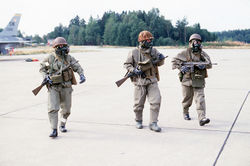 |
| Components |
|---|
|
Navy (Coast Guard) Air Force Home Guard |
| Ranks |
| Norwegian military ranks |
| Bugle calls |
| Bugle calls of the Norwegian Army |
| Armed Forces equipment |
| Army equipment Norwegian naval ships Norwegian military aircraft |
The Norwegian Army (Norwegian: Hæren, established in 1628, is the branch of the Norwegian Armed Forces responsible for land-based military operations. It is the largest branch of the Norwegian armed forces. The modern Army has its roots in the post-ww2 rebuilding of Norway.
The Royal Norwegian Army currently has a peacetime strength of 22,000, and approximately 51,000 when fully mobilized.[1] The Army is mainly located in two bases in (1)mid-Troms and (2)the south-eastern part of the country, with other units like the King's Guards and the border guards stationed elsewhere. Norway has 479 troops, as well as special forces , abroad according to the Norwegian Armed Forces homepage.[2]
Contents |
Early years and formation
The Norwegian Army dates back to Viking times, when it consisted of only the household forces of local kings and their allies. The present army was established by the Danish-Norwegian king Christian IV "to defend the kingdom against external dangers." This is still the Norwegian Army's primary mission.
The Norwegian Army's first great victory of the came in 1808, when the Swedes attempted to invade Norway from the south, but were forced back by the forces of Prince Kristian August. In 1814 the Swedes invaded again, this time with the support of the victors of the Napoleonic Wars. The Swedish king intended to take Norway by force, but the Norwegian Army could not be broken despite severe losses; as a result the war ended with the Swedish king accepting Norway as a separate state with its own constitution - but the Norwegians having to accept him as a king. The officer class was well represented in the forming of the Constitution in 1814, which included clauses providing for a Norwegian national army based on compulsory service.
In 1905, the Storting voted to separate from Sweden. The army had been modernised and were highly trained in the years before 1905. War seemed inevitable and 22,000 men were mobilised, but Norway achieved independence peacefully.
World War II
The greatest accomplishment of WW2 by Norwegian forces was the victory in the battle of Narvik, especially the mountain war forcing the German forces all the way from the ocean to the Swedish border. In addition to the Norwegian Campaign, Norwegian soldiers joined the Norwegian resistance movement after German forces occupied Norway. Likewise, many Norwegian Army members served with the German forces. Norwegian soldiers also joined free Norwegian units in the United Kingdom to continue the fight against the Nazis. These units included the Norwegian Independent Company 1 and 5 Troop, No.10 (Inter Allied) Army Commandos. The bulk of the Norwegian Army during the years in exile in Britain consisted of a brigade in Dumfries as well as smaller units stationed in Iceland, Jan Mayen, Svalbard and South Georgia. Units from this brigade took control over Finnmark in 1944 after the German retreat from the Red Army. The Home Front (Hjemmefronten) was the a Norwegian resistance movement during Nazi Germany's occupation of Norway (1940–1945).
Exile and the Scottish Brigade

In August 1940 Army High Command took over command of the Norwegian Army camp, Dumfries, Scotland. The camp was established in June 1940 and named Norwegian Reception Camp Dumfries, consisting of some 500 men and women, mainly foreign-Norwegian who had volunteered for war duty in Norway during the Nazi-occupation in the spring of 1940. When the Army High Command took over, there were 70 officers and about 760 privates in the camp. Throughout the summer the numbers increased to around 1,500 as several Norwegians stranded abroad made it to Britain. It was however not a big growth, many of them were transferred to the Norwegian and British navies, Norwegian merchant ships, air force or SOE.[3]
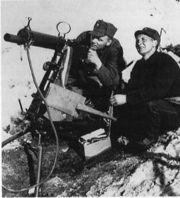
The soldiers in Dumfries had uniforms and had no heavy equipment brought over from Norway, including machine guns and artillery. Arming of the Norwegian Army had at this time little priority for the British Government. Later on the British Government would give them weapons of varying quality, for a large part surplus material from World War I.[3]
General Carl Gustav Fleischer head of the Army High Command, had pressed the Norwegian government in exile for the implementation of discharge of all Norwegians in conscription on the British Isles. On 22 August 1940 the British Government adopted the United Allied Forces Act, which gave the Allied states authority to exercise military power on British territory. After lengthy hesitation, the exiled government adopted a provisional regulation on conscription of all male Norwegian citizens from 18 to 55 years of service in the armed forces.[3]
In October 1944, 208 Norwegian men from the 2 mountaineer company (2 bergkompani) were sent to Murmansk and attached to the Soviet Red Army's 114th Rifle Division. Armed forces High Command had wanted to send a larger force, but the transport of the Norwegian soldiers and their equipment was not given priority by the Allies. After some complex diplomatic maneuvering, it was decided to send a "symbolic force" of 230; capacity restrictions reduced the final number to 208 men, who arrived in Murmansk without vehicles among other things. Between 9 and 11 November the Norwegian soldiers crossed the border into Sør-Varanger, Norway and was placed in the city of Kirkenes.[3]

On 24 November the mountaineer company was sent to the front against the Germans. Their mission was to secure the region towards the end of the German forces' retreat and take and interrogate prisoners, and attacking the German back troops. The company operated from November to February independently and spread over a large area. On 6 February, the 2. Mountaineer Company in Finnmark detached themselves from the Soviet forces and transferred themselves to district commando of Finnmark under Colonel Arne Dahl. They were reinforced with 1,300 men from the Norwegian police forces in Sweden, and other Norwegian military companies that were set up in the liberated areas.[3]
The Cold War
The Norwegian Army sent the Independent Norwegian Brigade Group in Germany in 1947 to support British forces occupying North Western Germany. The brigade was disbanded in 1953. Norway was one of the founding members of NATO, and during the Cold War, the Norwegian Army's primary role was the defence of Norway and Western Europe's northern flank. British, Dutch and US Marines were tasked to assist in the defence of Norway during any Soviet invasion.
The Cold War was a period with sometimes high tension in eastern Finnmark, at the 196 km long border with the Soviet Union.[4] To keep tensions from getting too high, Norway declared that no NATO exercises would take place in Finnmark. There was, however, a lot of military intelligence activity, and Norwegian P-3 Orion maritime surveillance aircraft were often the first to get pictures of newly built Soviet submarines and aircraft.[4] A purpose built ELINT vessel, the Marjata, was always stationed near the border, and the current Marjata (7500 tons) is still operating out of the ports in eastern Finnmark. As recent as 2000, Russian generals threatened to target nuclear missiles at the Globus II Radar in Vardø.[4][5]
The Directives for Military Officers and Ministry Officials upon an Attack of Norway has only been close to implementation once in Norwegian history. On 3 June 1968 the Leningrad Military District in the former Soviet Union was placed on alert. Within a couple of days the mobilized forces in the Leningrad region reached 11,000 soldiers, 4,000 marines, 210 tanks, 500 troop transports, 265 self propelled cannons, 1,300 logistics transports, 50 helicopters and 20 transport aircraft (Antonov AN-12), all of which were staged in the Petchenga-Murmansk area near Norway.[6]
On the evening of 7 June, the garrison (Garnisonen i Sør-Varanger or GSV) heard the noise of powerful engines coming from the manoeuvres along the entire Soviet front of the Norwegian-Soviet border. Actual observations were not possible over the border in the dark. On that same night the GSV commanding officer ordered all GSV reserve forces to report to their emergency muster locations. The Soviet demonstration of strength lasted until 10 June, when the Soviet forces backed down.[6]
Norway has also contributed to NATO and United Nations peacekeeping forces. Since 1947 Norway has contributed military personnel to over 40 international operations abroad and some 120,000 Norwegians have served in these operations. The major missions have been UNIFIL (Lebanon), IFOR/SFOR (Bosnia) and KFOR (Kosovo), as well as multiple contributions to UN observer missions.
War on Terror
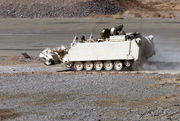
Norway along with other Scandinavian countries, supported the US War on Terror. The Norwegian government was one of the strongest supporters for the war, Jens Stoltenberg even said “It is also in our interests to hit back against such attacks,” but added later “we assume that the USA is not interested in retaliating in any way which could pose a threat to world peace.” Norwegian Defence Minister at the time, Bjørn Tore Godal, said “the United States is Norway’s most important ally. Norway is already providing intelligence assistance to the United States. If we receive a request for further support, including military support, we will of course respond positively, and in accordance with the obligations of article 5 of the NATO treaty.”[7]
The Norwegian Army sent troops to support the NATO ISAF mission in Afghanistan, to help free Afghanistan of the Taliban. Norwegian special forces were involved in combat operations during Operation Enduring Freedom in 2002, and Norwegian Army troops during Operation Harekate Yolo in 2007.[8] About 590 Norwegians are serving in the ISAF force.[4]
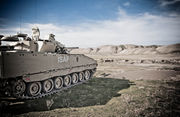
According to Aftenposten, the Norwegian Army base at Meymaneh is amongst the least secure bases in Afghanistan, the base is less secure than other bases belonging to other the International Security Assistance Force (ISAF). Meymaneh is located in the northwestern region of Afghanistan, the region has become increasingly restless in recent years. Taliban has grown in numbers in the region, Taliban has been able to attack Meymaneh many times. Both military and political heads of the armed forces, agreed with the Norwegian Armed Force about the weakened state of their base. When the Norwegian Army was asked for what they needed to defend their position, they asked for 120 troops and long-range weapons. They also ordered a mobile reaction force, so that allies in the region could assist each other if they came under heavy attack by Taliban or similar rebel organisations.[9]
Ranks and insignia
Before the unit officers was introduced around 1930, in Norway, a system similar to what you have in almost all other countries with two separate career paths:
- That non-commissioned officer is most of his career a section troop commander and second officer, and thus is the leading soldier.
- As the officer who is academically trained, and that previously came from the upper class, who starts his career with a few years as a platoon leader to get some practical experience, but that is focused on command and staff work at higher levels.
Equipment
Organisation

In 2009 the Army introduced the new command and control lines. The General Inspector now commands three subordinate major commands and 5 smaller support units:[10][11]
- Brigade Nord
- Army Special Forces Command (FSK/HJK)
- Army Weapons School
- HM the Kings Guard
- Garnisonen i Sør-Varanger
- Military Academy
- Logistics and Operational Support
- Operation Support Detachment
Garrisons
| Garrisons | Brigades / Companies |
|---|---|
| Jørstadmoen |
FK KKIS(Defence command and control center) CIS TG (Communications and informations systems task group) FIH (Defence engineer school) . FOST (Defence security agency) |
| Huseby Leir |
HMKG ( His Majesty The Kings Royal guard) |
| Rena Leir |
Hærens Våpenskole (Army weapons school) Telemark Battalion and attached medical, engineer and logistics companies provided by respective battalions. HJK/Forsvarets Spesialkommando (Army and Joint special forces command) |
| Terningmoen leir |
Hærens Våpenskole (Army weapons school) HMKG school center (His Majesty The Kings Royal guard)) Military Academy AFA-Office (Administrative parental department) |
| Sessvollmoen |
FKL (Logistics support center) FMPS (Defence military police school), FSAN (Defence medical center) |
| Skjold | Brigade Nord
Engineer battalion and 2. battalion |
| Setermoen | Brigade Nord
Armor battalion, Intelligence battalion, Medical battalion and Artillery battalion |
| Bardufoss | Brigade Nord
Signals battalion and CSS battalion |
| Porsangermoen | Garrison of Porsanger |
| Høybuktmoen | Garrison of Sør-Varanger |
| Linderud Leir | Military Academy |
References
- ↑ "Forsvarsnett: The Norwegian Army" (in Norwegian). Forsvaret. Archived from the original on 2007-09-30. http://web.archive.org/web/20070930201119/http://www.mil.no/haren/start/fakta/fakta_ark/. Retrieved 2007-03-20.
- ↑ "Norske styrker i utlandet" (in Norwegian). Forsvaret. http://www.mil.no/intops/start/article.jhtml?sourceID=260011&source=ftd. Retrieved 2009-02-17.
- ↑ 3.0 3.1 3.2 3.3 3.4 [http://home.online.no/~gestrom/history/nbrigfrm.htm "The Norwegian Brigade in Scotland 1940 - 1945"]. Home.Online.no. http://home.online.no/~gestrom/history/nbrigfrm.htm. Retrieved 15 February 2009.
- ↑ 4.0 4.1 4.2 4.3 Kjell Dragnes (20 April 2008). "Spioner over grensen" (in Norwegian). Aftenposten. http://www.aftenposten.no/kul_und/litteratur/article2378871.ece. Retrieved 15 February 2009.
- ↑ "Norsk radar viktig for USA" (in Norwegian). Aftenposten. 11 October 2005. http://www.aftenposten.no/nyheter/iriks/article1131928.ece. Retrieved 15 February 2009.
- ↑ 6.0 6.1 "Cold War" (in Norwegian). Pasvikelva.no. http://www.pasvikelva.no/index.php?page_id=2&article_id=104&lang_id=2. Retrieved 16 February 2009.
- ↑ Steve James. "Scandinavian governments support Bush’s war against terrorism". World Socialist Web Site. http://www.wsws.org/articles/2001/oct2001/scan-o04.shtml. Retrieved 4 October 2001.
- ↑ Vegar Gystad. "Vi har trent for dette lenge" (in Norwegian). Forsvaret. http://www.mil.no/start/article.jhtml?articleID=147513. Retrieved 15 February 2009.
- ↑ Catherine Stein (5 Juli 2008). "Norwegian base weakest in Afghanistan". Aftenposten. http://www.aftenposten.no/english/local/article2466146.ece. Retrieved 15 February 2009.
- ↑ http://www.mil.no/multimedia/archive/00136/0560_H_rbrosjyren_N_136081a.pdf
- ↑ http://www.mil.no/haren/start/org/start/;jsessionid=XSEGJKECM4GQ1QFIZYGSFEQ?_requestid=27674
External links
|
||||||||||||||||
|
||||||||||||||||||||||||||||||||
